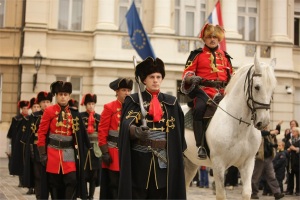The story of Croatia cannot be told without recounting the bloody conflict between the nations of former Yugoslavia that preceded modern nationhood. In one of the most severe European conflicts following World War II, the nations of Croatia, Slovenia, and Bosnia and Herzegovina sought independence from the Socialist Federal Republic of Yugoslavia. Croatia’s role in the conflict marked a pivotal moment in the history of Croatia and the Croatian identity.
Following the death of Josip Broz Tito in May of 1980, Yugoslavian leaders struggled to rein in the formerly latent nationalistic movements that had begun to gain momentum. The calls for increased autonomy clashed with the upsurge in Yugoslavian unity in Serbia, as well as with the Yugoslavian National Army (JNA) and other preeminent authorities.
Nine years later, the Croatian League of Communists was calling for political reform and free, multi-party elections. After the elections in April and May of 1990, Franjo Tuđman and the Croatian Democratic Union were swept into power. A new constitution was adopted in December of 1990, followed by the Declaration on the Proclamation of the Sovereign, Independent Republic of Croatia in June 1991. It was this act, and similar developments in other regions of Yugoslavian, that contributed to the annihilation of the Yugoslavian state in October of 1991.
Earlier in 1990, Slobodan Milošević, one of the foremost leaders of Serbia, began leading the charge for “Greater Serbia” and called on Serbians in Croatia to rebel against Croatian authorities. By April of 1991, rebellious Serbian extremists called for the cessation of the Croatian region of Krajina, and aimed to annex themselves to Serbia.

The town of Vukovar after a three month siege from the Yugoslavian National Army. Source: http://croatia.eu/article.php?lang=2&id=24
The fighting commenced in April of 1991, with the Yugoslavian National Army joining the Serbian rebels in Croatia. The conflict eventually grew to include Serbia and Montenegro, and would come to be known in Croatia as the Homeland War. Several Croatian towns were exposed to mortar and artillery attack, including Vinkovci, Osijek, Karlovac, Sisak, Gospić, Zadar, Šibenik and Dubrovnik. Much of the fighting also took place in the Croatian province of Slavonia. By the end of the War in 1991, over 14,000 people had been killed. Nearly 550,000 people were displaced within Croatia, and another 20,000 refugees fled from Bosnia and Herzegovina. According to the 2003/04 report compiled by the Europe Review:Economics and Business, “much of Croatia was devastated, with estimates ranging from 21–25% of its economy destroyed and an estimated US$37 billion in damaged infrastructure, lost output, and refugee-related costs.”

The attack of the city of Dubrovnik, December 1991 Source: http://croatia.eu/article.php?lang=2&id=24
Croatia was recognized by the European Community in January of 1992 and later by the United Nations in May. International mediate and peace-keeping efforts over the next three years largely failed, and violence and conflict continued in the region. in 1995, Croatian undertook an initiative to re-take the occupied territory held by the Serbian rebels, known as Operation Storm. The mission was largely successful, as it allowed 85,000 displaced Croats to return. However, it is estimated that 150,000 Croatian Serbs were displaced as a result of the undertaking.
By November 1995, a peace agreement was reached between the Croatian, Bosnian and Serbian sides, known as the Basic Agreement on Eastern Slavonia, Baranja and Western Srijem, or the “Erdut Agreement.” The UN took charge of of the contested territory of Slavonia, and began the process of re-integrating the region back into the Croatian governmental administration. Over the next few years, Croatia would continue to negotiate with other former Yugoslavian nations over issues of territory and boundaries.
After the war, over 35,000 people were listed as wounded, and nearly 52,000 were labeled as disabled due to their participation in the War. Additionally, nearly two million mines and minefields were put down in Croatia during the war, many with no pattern or surviving record. Rains and floods continue to expose new mine fields, and the hiking in the mountainous areas in the north of the country carries a travelers warning from the US government.
Croatia is a country that is moving forward from the war, ready to put the painful memories of the conflict behind it. While there antagonistic feelings still exist between the participants, Croatians will not be quick to disregard the devastation that could arise from another such war.
Croatia’s affiliation with NATO in April 2009 and its accession to the European Union (EU) in July 2013 created an image of Croatia as safe country which was providing a stable environment in the Balkan Region. After the war, it is now judged to be a peaceful nation with little risk of once again becoming involved in a similar conflict.
On July 1, when Croatia became the EU’s 28th member and only the second former Yugoslav republic to join the EU, its borders with Serbia, Bosnia and Herzegovina and Montenegro became the EU’s new external border. While Croatia’s external borders were once a soft administrative line between Yugoslav republics, vaguely defined and ignored at will, they are now one of the most vigorously observed frontiers, separating villages and peoples who for generations shared a single state and crossed at ease.

(1) Describe actual, imminent, or possible inter- or intranational conflict challenges tracing Croatia. As part of your answer to this part of the question, look at Croatia’s Global Peace Index ranking and examine its various peace indicators.(2) Is Croatia a source, a cause of international conflict? Is Croatia, for example, a major arms supplier? (See Global Peace Index.) How do you explain/justify this? (3) What is the legacy of the Balkans War in the 1990s? Are their lingering concerns about Croatia’s security?